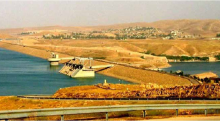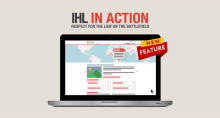Case prepared by Cécile Lecolle, Sunethra Sathyanarayanan and Clémence Volle-Marvaldi, LL.M. students at Leiden University under the supervision of Professor Robert Heinsch as well as Sofia Poulopoulou, PhD researcher, Kalshoven-Gieskes Forum, Leiden University.
A. CIVILIAN HARM TRACKING AND CASUALTY RECORDING BY ISAF AND UNAMA
[…]
Civilian harm tracking and casualty recording are two distinct approaches to documenting civilian harm and are increasingly recognized as emerging practice by states, conflict parties, international organizations, and civil society. In Afghanistan, the NATO-led International Security Assistance Force (ISAF) and the United Nations Assistance Mission in Afghanistan Human Rights Unit (UNAMA HR) use these respective approaches.
[…]
ISAF - Civilian Casualty Tracking in Practice
ISAF leadership created the CCTC [Civilian Casualty Tracking Cell] in 2008 because of the need to address allegations of ISAF-caused civilian casualties. The initial mechanism was modest, requiring little planning and reallocation of resources. A small CCTC staff collected and centralized data reported from the field, using the data to attempt to verify civilian casualty allegations and keep ISAF leadership informed. By late 2009, the CCTC amassed enough data to analyze it for trends. This aggregated data was used for reports and recommendations addressing civilian casualty mitigation for ISAF leadership.
The CCTC’s work proved valuable, prompting ISAF in 2011 to expand the mechanism into the Civilian Casualty Mitigation Team. The expansion gave the mechanism more personnel, resources, and responsibility, including increased engagement with civil society on civilian casualty concerns. Its data was used to influence recommendations for tactical directives and pre-deployment training.
In implementing the CCTC and subsequent CCMT [Civilian Casualty Mitigation Team], ISAF repeatedly emphasized the importance of tracking, helping make it a priority down the chain of command.
[…]
B. UPDATED TACTICAL DIRECTIVE ISSUED BY ISAF GENERAL AIMING AT PROTECTING THE CIVILIAN POPULATION
[...]
International Security Assistance Force Commander, General David Petraeus has issued his updated Tactical Directive, providing guidance and intent for the use of force by ISAF and USFOR-A [US Forces-Afghanistan] units operating in Afghanistan.
“The Tactical Directive reinforces the concept of “disciplined use of force” in our partnership with Afghan Security Forces to defeat the insurgency in Afghanistan.
The updated directive is classified; unclassified portions of the document are included below.
“This directive applies to all ISAF and US Forces-Afghanistan (USFOR-A) forces operating under operational or tactical control ... Subordinate commanders are not authorized to further restrict this guidance without my approval.
Our counterinsurgency strategy is achieving progress in the face of tough enemies and a number of other challenges. Concentrating our efforts on protecting the population is having a significant effect. We have increased security in some key areas, and we have reduced the number of civilian casualties caused by coalition forces.
[…]
We must continue – indeed, redouble – our efforts to reduce the loss of innocent civilian life to an absolute minimum. Every Afghan civilian death diminishes our cause. If we use excessive force or operate contrary to our counterinsurgency principles, tactical victories may prove to be strategic setbacks.
[…]
Prior to the use of fires, the commander approving the strike must determine that no civilians are present. If unable to assess the risk of civilian presence, fires are prohibited, except under of the following two conditions (specific conditions deleted due to operational security; however, they have to do with the risk to ISAF and Afghan forces).
[…]
We must train our forces to know and understand the rules of engagement and the intent of the tactical directive. We must give our troopers the confidence to take all necessary actions when it matters most, while understanding the strategic consequences of civilian casualties.
[…]
Some civilian casualties result from a misunderstanding or ignorance of local customs and behaviors. No individuals are more attuned to the Afghan culture than our Afghan partners. Accordingly, it is essential that all operations be partnered with an ANSF unit and that our Afghan partners be part of the planning and execution phases. Their presence will ensure greater situational awareness. It will also serve to alleviate anxiety on the part of the local population and build confidence in Afghan security forces.”
[…]
The directive was issued on August 1, 2010, replacing the July 1, 2009 version.
C. NATO NATIONS APPROVE CIVILIAN CASUALTY GUIDELINES IN AN EFFORT TO REDUCE THE IMPACT OF THE CONFLICT ON THE CIVILIAN POPULATION
In an effort to find a common approach to deal with the tragedy of civilian casualties, NATO nations have agreed on a set of guidelines which have now been promulgated to the Chain of Command. These guidelines reflect the efforts NATO/ISAF is making to reduce the impact of the conflict on the people of Afghanistan. The centre of gravity of NATO’s mission remains the Afghan people, and ISAF does everything within its power to avoid harming civilians. When combat-related civilian casualties or damage to civilian property occur, NATO/ISAF considers that easing civilian suffering is of tremendous importance. In Afghanistan, the pain of losing a family member can also have financial implications, which could be eased through payments. Afghans have made it clear that payments to the families of civilian casualties is a culturally-appropriate response to combat-related civilian death or damage to private property. For this reason, NATO nations have agreed on the following set of non-binding policy guidelines for when they deal with cases of civilian combat-related casualties.
- Promptly acknowledge combat-related cases of civilian casualties or damage to civilian property.
- Continue to fully implement the ISAF standard operating procedures for investigating possible cases of civilian casualties, or damage to civilian property, and endeavour to provide the necessary information to the ISAF civilian casualties tracking cell.
- Proactively offer assistance for civilian casualty cases or damages to civilian property, in order to mitigate human suffering to the extent possible. Examples of assistance could include ex-gratia payments or in-kind assistance, such as medical treatment, the replacement of animals or crops, and the like.
- Offers of such assistance, where appropriate, should be discussed with, and coordinated through, village elders or alternative tribal structures, as well as district-level government authorities, whenever possible. Assistance should also, where possible, be coordinated with other responsible civilian actors on the ground.
- Offering and providing such assistance should take into account the best way to limit any further security risk to affected civilians and ISAF/PRT personnel.
- Local customs and norms vary across Afghanistan and should be fully taken into account when determining the appropriate response to a particular incident, including for potential ex-gratia payments.
- Personnel working to address cases of civilian casualties or damage to civilian property should be accessible, particularly, subject to security considerations, in conflict-affected areas, and local communities made fully aware of the investigation and payment process.
- The system by which payments are determined and made should be as simple, prompt and transparent as possible and involve the affected civilians at all points feasible.
- Payments are made and in-kind assistance is provided without reference to the question of legal liability.
- D. UNAMA REPORT CONFIRMS THE DECREASE IN THE NUMBER OF CIVILIAN CASUALTIES CAUSED BY PRO-GOVERNMENT FORCES IN 2009
[…]
The findings of UNAMA’s human rights team […] indicate that 2009 saw a reduction of 28 per cent compared with 2008 in the number of civilian casualties caused by pro-Government forces.
This decrease reflects measures taken by international military forces to reduce the risk posed by military operations on the civilian population.
[…]
E. REDUCTION IN THE NUMBER OF CIVILIAN CASUALTIES CAUSED BY PRO-GOVERNMENT FORCES FOLLOWING NEW TACTICAL DIRECTIVES
[…]
In late 2008, General McKiernan, the ISAF Commander in Afghanistan, established the first Civilian Casualty Tracking Cell (CCTC) in ISAF – to better enable his commanders and staff to monitor harm to civilians. In mid-2009, as leaders grew to realize that civilian casualties were in fact adversely impacting the stability mission, the next ISAF Commander, General McChrystal issued a Tactical Directive (6 July 2009) that stated:
”We must avoid the trap of winning tactical victories – but suffering strategic defeats – by causing civilian casualties or excessive damage and thus alienating the people.... I expect leaders at all levels to scrutinize and limit the use of force like close air support (CAS) against residential compounds and other locations likely to produce civilian casualties.... The use of air-to-ground munitions and indirect fires against residential compounds is only authorized under very limited and prescribed conditions.” [Headquarters, ISAF, 6 July 2009]
After gathering data for several months, the CCTC was then able to identify/assess CIVCAS [Civilian Casualties] trends over time. Based on those assessments, the ISAF Commander developed and issued additional guidance to the force – adjusting ISAF's tactics and procedures in order to further decrease harm to civilians. For example, when data began to show that Afghan civilians were being killed in numerous traffic accidents caused by ISAF forces/drivers, the ISAF Commander issued a directive on driving (30 August 2009), which instructed soldiers to avoid aggressive driving and to instead emphasize safe driving. Likewise, when night raids were found to be contributory to Afghan casualties as well as cause for great irritation/anger among host nation citizens, the ISAF Commander issued a directive on night raids (5 March 2010), which directed commanders/units to explore all other feasible options before conducting any night raid in the vicinity of compounds and residences. That directive further stated the following:
”The ISAF policy on Night Raids builds upon earlier directives which establish guidance on entry into Afghan medical facilities to respect and protect innocent civilians; on driving, instructing ISAF personnel to adhere to appropriate, legal driving procedures and behavior in Afghanistan; and, an overarching Tactical Directive which provides guidance and intent for the employment of force in support of ISAF operations by gaining and maintaining the support of the people, by separating the insurgency from the innocents, and by avoiding civilian casualties through the application of an appropriate use of force.”[Headquarters, ISAF, 5 March 2010]
Subsequent ISAF commanders continued to place strong emphasis on CIVCAS prevention. For example, General Petraeus modified the Tactical Directive (4 August 2010) to more effectively protect civilians across the range of situations where they could be involved. General Allen likewise issued his Tactical Directive (30 November 2011) – calling for an even more judicious application of force, soldier discipline, tactical patience, and regular reinforcement training – guided by Rules of Engagement (ROE). An OEF [Operation Enduring Freedom] CIVCAS Smart Card and an OEF CIVCAS Handbook were also produced to facilitate awareness and education across the force. In conjunction with these directives and supplements, the CCTC provided the comprehensive data and trend analysis that informed ISAF commanders. That analysis enabled commanders to make informed decisions and to adjust tactics and procedures as needed.
The results speak for themselves. Civilian casualty rates dropped significantly over a 4-year timeframe. According to the United Nations Assistance Mission in Afghanistan (UNAMA), 828 civilians had been killed by pro-government forces (ISAF and host nation security forces) in 2008. One year later, in 2009 (Note: the CCTC was stood up in late 2008 and General McChrystal's Tactical Directive was issued in July 2009), the number of civilian casualties caused by pro-government forces dropped to 596. By 2012, the number of civilian casualties caused by pro-government forces was down to 316. Overall, through tracking, analysis, and recognition of how much civilian harm was occurring and its causes, ISAF commanders were able to adapt and make a positive impact on both CIVCAS reduction and host nation attitudes.
[…]
Discussion
I. Classification of the Situation and Applicable Law
1. How would you classify the situation in Afghanistan in 2008? What additional information would you require to make such a determination? (
GC I-IV, Art. 3,
PII, Art. 1)
2. Was NATO party to an armed conflict in Afghanistan in 2008? Were the troop-contributing member countries of NATO parties to the conflict? Does NATO's involvement in Afghanistan influence the classification of the conflict?
II. Conduct of Hostilities
4. Is there an obligation under IHL to document civilian harm resulting from attacks launched by the parties to the conflict? Are the parties to the conflict expected to assess whether there will be civilian casualties prior to launching an attack? After an attack is carried out? (
PI, Arts 51,
57;
PII, Art. 13;
CIHL, Rules 1,
14,
15)
5. Are attacks only lawful if they do not result in death and injury of the civilian population? Does the fact that civilian deaths and destruction of civilian property occur mean that IHL is violated? Does IHL obligate a party to avoid civilian casualties at all costs? What guidance, if any, does IHL provide on weighing military objectives against anticipated civilian casualties? Are indiscriminate attacks prohibited under IHL? (
PI, Arts 51,
57;
CIHL, Rules 11,
14,
15)
6. Does the ISAF Directive refer to IHL, explicitly or implicitly? Which IHL principles are reflected in the Directive? Can the Directive be seen as going beyond the requirements set by these principles? (
PI, Arts 48,
51,
57;
PII, Art. 13;
CIHL, Rules 1,
14,
15)
7. (
Document A and B) Does IHL oblige the parties to the conflict to make sure that its military personnel are familiar with the rules of IHL? What is the importance of pre-deployment training? Is there a duty under IHL to identify trends of civilian casualties from past operations and to integrate the findings in the future training programs? (
PI, Arts 83,
87;
P II, Art. 19;
CIHL, Rule 142)
III. Elements Contributing to Respect for IHL
8. (Document A) Why did ISAF feel the need to “address allegations of ISAF-caused civilian casualties” by creating the CCTC mechanism, and to “increase engagement with civil society on civilian casualty concerns”? To what extent may external pressure or public opinion have an impact on the behavior of armed forces?
9. (Documents B and C) What do you think the Force Commander means by saying that “every afghan civilian death diminishes [their] cause” or that “tactical victories prove to be strategic setbacks”? Similarly, why is it felt important to better understand the local customs and norms of Afghan people in the conduct of hostilities?
10. (Document C) Is there a military interest in acknowledging combat-related cases of civilian casualties or damage to civilian property?
11. (Documents B and C) Why is it important for foreign or coalition forces to partner with local forces? Why do you think that ISAF and US Forces-Afghanistan want to “build confidence in Afghan security forces”?
12. (Document B and C) Can the existence of common rules of engagement among coalition forces contribute to compliance with IHL?
13. (Document B) Why do you think the ISAF and US Force-Afghanistan pursue “disciplined use of force” in their partnership with Afghan Security Forces? Is there an obligation for a State to ensure compliance by its partner forces?






